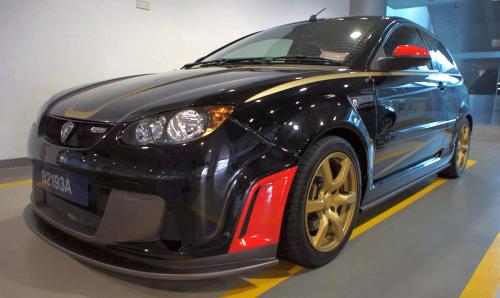The boys from Proton Motorsports have certainly been a busy lot of late – the latest and brightest to emerge from the stable is a car that made a quiet appearance during last week’s Lotus Renault GP team visit to Proton’s headquarters.
It’s a Satria Neo R3 that’s been given the supercharged treatment, in this case with a unit from Australian-company Sprintex, mounted behind the Campro mill. Set to have 180 hp and 200 Nm on call, this is another Neo that has some serious muscle – late last year, R3 displayed a turbocharged concept at the 2010 KL International Motorshow.
Exterior-wise, the car wears the bodykit from last year’s Satria Neo R3 Lotus Racing edition, with a black paint finish accented with red highlights and gold for trim and wheels making for this one’s clothes. Red is featured inside the cabin as contrast shade.
The sad news is that you can’t lay your paws on one – the supercharged offering is just a prototype study, part of R3’s constant exploration into improving the performance of Proton cars, as the division puts it.
In any case, we’re told that it’s still at a very early stage of development, where there are no benchmark performance figures (aside from the as planned rated power and torque above) to be had. Indeed, there are plenty of tests and evaluation cycles ahead for the car.
As such, there are currently no timelines on when or if this will enter production. However, if R3 were eventually to offer this for sale with a car, or as a kit, it should have all the standard Proton warranties, we’ve also been told. Now, supercharger, anyone?
Gallery after the jump.
[zenphotopress number=999 album=2140]
AD: Drive the Proton model of your dreams. Submit your details and Proton PJ will get in touch with you.
Looking to sell your car? Sell it with Carro.























AI-generated Summary ✨
Comments on the blog post reflect a mix of excitement and skepticism about Proton's supercharged Neo. Many are enthusiastic about the engine’s potential, praising its performance, especially the 180 hp and 200 Nm figures, and hope it will be affordable. Some express disappointment that the project may not reach mass production, citing past Proton issues like interior problems and slow development. There are also suggestions to upgrade existing models, like adding turbo or supercharge kits, and a desire for better exterior and interior designs. Several comments make comparisons with international brands, emphasizing that Proton should focus on quality, reliability, and competitive pricing to succeed internationally. Overall, the sentiments are positive but cautious, emphasizing the need for careful development, proper testing, and timely market release.